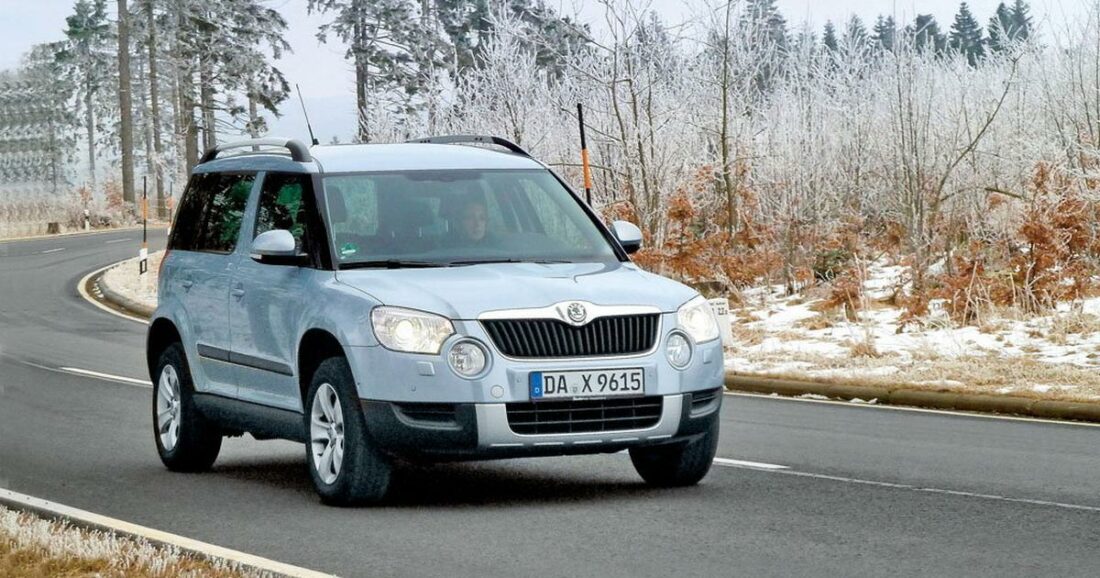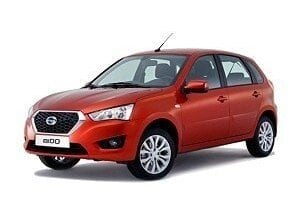
Odakoda Yeti 1.8 TSI (118 kW) 4 × 4 Experience
The Škoda Yeti has found a great niche. In its class, it means something akin to the Panda 4 × 4: it is a car for the average person who often has to deal with driving in harsh living conditions.
This can mean sand, earth, mud, but since this is just a Yeti, let it snow. He could not come to our exam at a better time. The sky hurled snow like never before. The good thing about cars like the Yeti is that you don't have to think a lot about how to prepare the technique to tow the car well when it gets hit by the wheels, such as snow.
The drive is nimble: while there are no problems with traction, the engine drives only one pair of wheels, but when it starts to slip, another pair comes to the rescue. All the driver needs to do is focus on reducing the physical capacity associated with such a situation. So be careful.
If you turn from a plowed road onto an asphalt road that is still plowed and covered with snow, such a Yeti will pull without any problems. Even uphill. One has only to know that the steering wheel and brakes become less responsive, because even such a good ride will not help here. Even fresh snow will not frighten the Yeti, unless, of course, it is too deep.
The tires are capable of propelling the car forward until the belly rests on the snow. And the belly of such a yeti, as you can see from the photo, is quite high. At a distance of 18 centimeters from the ground, it is already very close to real SUVs.
It has been tested and verified that the Yeti can go very far even in rather deteriorating conditions under the wheels, but there are still some small inscriptions. There is a button on the dashboard with a label showing the car sliding, and underneath it there is an off.
Anyone who expects that it can be used to turn off the ESP stabilization system and add their own driving skills to the technical capabilities of the drive is mistaken, thereby increasing the coefficient of pleasure. The button only disengages the ASR drive, which only slightly improves traction in deep snow, because when the ASR (traction control) system is activated, the electronics interfere with the engine and prevent the wheels from moving into neutral. However, this is exactly what a driver sometimes needs in snow (or mud).
For this, that is, for driving on snow (or, I repeat, in other cases when contact with the ground is broken), engine, who rode the test Yeti, very ready. The petrol turbo engine develops a lot of torque and until recently didn't have to worry about such frequent turbo holes - it constantly pulls and thus makes it easy to use the drive on snow at all speeds.
So this Yeti could be a perfectly finished winter car if it had heated seats. But even without this, you can spend the first ten minutes of the ride, since the seats, fortunately, are skinless. When we are with them, we have no comments: he claims that they do not tire during long rides, but they are also a little sideways, but above all, they are the right size and comfortable.
And what is written roughly applies to everything interior: here it is clearly evident that he does not want to express prestige, but gives the impression of superior quality in design, workmanship and materials. Thus, Škoda differentiates itself from other vehicles in this group without compromising on quality. And it works very well for them.
When it comes to ergonomics, Yeti has no major flaws. The audio system is very ready (it has room for six CDs, it also reads MP3 files, has an SD card slot and an AUX input for audio players, but only the USB input is missing), provides good sound, has large buttons and is intuitive to use. use. The air conditioner switches are somewhat diametrically different - small buttons with even smaller symbols on them, so you have to get used to them.
The sensors are also flawless, correct and without remarks, but they are also dry white and devoid of nobility. Pri driving position The only thing that stands out is the rather high position of the steering wheel, which can hurt the driver’s shoulder on a long journey.
Even when it comes to build quality, the Yeti turns out to be excellent, and in the case of the test car, it also turned out that this problem is not immune from the fragility of the plastic parts: the ashtray covers (if so, we could not determine) protruded and did not allow themselves to open ... However, it is quite possible that this happened due to the hand of some "bricklayer" who used the car in front of us, since this Yeti has already shown more than 18 kilometers.
the last part Yeti is a perfect example of good and witty adaptability. The whole seat consists of three parts (40:20:40) that can be moved and removed individually. After a bit of testing, the seat can be quickly removed even without the instruction booklet, and its 15 kilograms is not very pleasant if you have to take it further.
In addition, installing the backrest is no longer as simple and straightforward as removing it. ... However, the performance is commendable, as a little more than the 400-liter base trunk can be converted into a 1 cubic meter hole in this way for a total vehicle length of just over 8 meters. Even the large rear doors and the correct shape of the space speak only about the convenience of using this car.
Most owners are likely to use such a Yeti mainly on well-groomed roads, so a turbocharged 1-liter gasoline engine is particularly suitable. It makes it easy and comfortable to drive, a little lazy behind the gear lever (but a little less than it would otherwise be, since the gearbox seems to be designed for a long time), but on the other hand, it can also be harsh.
His running is always calm, even quiet at low and medium revs, but then it gets quite loud. When accelerating, the speedometer needle quickly touches two hundred, without the need to drive the engine to the chopper (7.000 rpm) or to the red field (6.400). It seems to prefer cranking up to around 5.000 rpm, and when shifting to higher revs, it falls into the engine's acceptable torque range as it starts to accelerate well again.
Probably the only noticeable drawback of this engine its consumption, despite the large gear ratios - in fourth gear it spins on a breaker, in fifth up to 6.000 rpm, and sixth gear is already powerless at this speed.
Our rough measurements using the on-board computer at 100 kilometers per hour show in fourth gear. flow rate 8, 1 liters per 100 km, in the fifth 7, 1 and in the sixth 6, 7. For 160 kilometers per hour, the flow values are (4.) 14, 5, (5.) 12, 5 and (6.) 12, 0.
Practice shows the following: an empty Yeti with this engine consumes 130 liters when driving at a speed of 10 km / h on real roads (which also means lifting and lowering and reducing the speed limit due to special restrictions, but always be careful with gas.). 5 km. This, of course, is no longer the history written by TDI.
Anyone who opts for a gasoline engine probably knows exactly what and why, as the advantages over diesel - except for fuel consumption - are significant. But since Yeti is a member of the Volkswagen Group, you can (also) choose from a variety of (other) drive vehicles. Regardless of engine choice, it's important to know that the Yeti technically has no direct competitor.
There are several similar cars on the market (3008, Qashqai…), but here, besides flexibility and drive, many other things are important. For example, the aforementioned workmanship and materials, the possibility of a drive and additional equipment (by the way, the test Yeti had, with the exception of navigation and seat heating, everything you really need in the equipment, and much more) and to some extent also the appearance and image on market.
The damage is probably growing the fastest in recent years, or at least very close to it. Also because of the Yeti. Who could become a living legend of Škoda. The only pity is that, probably, everyone can’t afford it.
Vinko Kernc, photo: Vinko Kernc, Aleš Pavletič
Odakoda Yeti 1.8 TSI (118 kW) 4 × 4 Experience
Basic data
| Sales: | Porsche Slovenia |
|---|---|
| Base model price: | 24.663 € |
| Test model cost: | 26.217 € |
| Calculate the cost of auto insurance | |
| Power: | 118kW (160 KM) |
| Acceleration (0-100 km / h): | 8,4 with |
| Maximum speed: | 200 km / h |
| Mixed flow ECE: | 8,0l / 100km |
Technical information
| engine: | 4-cylinder - 4-stroke - in-line - turbocharged petrol - displacement 1.798 cm? – maximum power 118 kW (160 hp) at 4.500–6.200 rpm – maximum torque 250 Nm at 1.500–4.500 rpm. |
|---|---|
| Energy transfer: | the engine drives all four wheels - 6-speed manual transmission - tires 225/50 R 17 W (Continental ContiWinterContact M + S). |
| Capacity: | 200 km/h top speed - 0-100 km/h acceleration in 8,4 s - fuel consumption (ECE) 10,1/6,9/8,0 l/100 km, CO2 emissions 189 g/km. |
| Mass: | empty vehicle 1.520 kg - permissible gross weight 2.065 kg. |
| External dimensions: | length 4.223 mm - width 1.793 mm - height 1.691 mm - fuel tank 60 l. |
| Box: | 405-1.760 l |
Our measurements
| T = -2 ° C / p = 947 mbar / rel. vl. = 63% / Mileage condition: 18.067 km | |
| Acceleration 0-100km: | 8,4s |
|---|---|
| 402m from the city: | 16,0 years ( 137 km / h) |
| Flexibility 50-90km / h: | 7,7 / 10,3s |
| Flexibility 80-120km / h: | 11,2 / 13,5s |
| Maximum speed: | 200km / h (V.) |
| test consumption: | 11,7 l / 100km |
| Braking distance at 100 km / h: | 42,8m |
| AM table: | 40m |
| Test errors: | broken ashtray on the back bench |
evaluation
You have to get used to the fact that Škoda is better and better with every model. However, this Yeti not only gives the impression of excellent quality, but is also great as a family car or as a car for driving on the ground with poor traction. And it looks quite correct, even cute. Only the price ...
We praise and reproach
quality of design, workmanship and materials
motor abilities and character
Transmission
steering wheel, chassis
ride (in the snow)
ergonomics
rear flexibility
Equipment
price
heavy rear seats, inconvenient installation after removal
engine noise above 5.500 rpm
ESP does not switch
gearbox too long
no navigation, heated seats
mirrors in awnings are not illuminated
the audio system does not have a USB input
